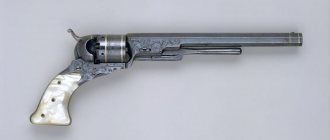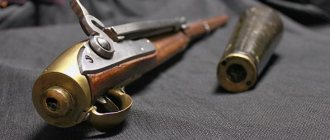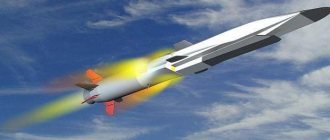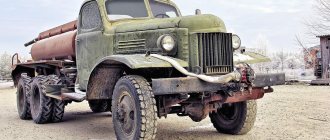Based on the results of tests and a competition in 1959, the newest creation of the Kalashnikov design bureau, the AKM, was adopted into service with the Soviet Army, which demonstrated high reliability, accuracy and accuracy when firing. In this case, a significant role was played by the fact that the Kalashnikov assault rifle of the previous modification had already been sufficiently mastered by industry, security forces and military personnel.
What's left of the AK
AKM retained the same scheme:
- Automation;
- Barrel bore locking system;
- Return mechanism;
- USM AKM with automatic and single fire, as well as a flag non-automatic sector of the translator-fuse;
- All systems and mechanisms were placed in the receiver.
It should be noted that in both products the moving parts of the automation have significant gaps. This ensures reliability in its operation, including operation in conditions of significant pollution, which increase the load on the gas chamber, so holes for the release of powder gases into the AKM were made in the gas chamber.
MAKSIMOV.SU
Despite acceptable
or even good trigger characteristics on military AKs, civilian Kalashmats often require improved trigger operation
Topic
for selling products from Andrey “Frezer” on Guns.ru Much of what is ingenious is usually truly distinguished by its simplicity.
For weapons, the combination of genius and simplicity of design solutions is of particular importance. In this article we will talk about a surprisingly simple, but effective and well-thought-out tuning element for the most popular “people's carbine” - the fenced AKM (VPO-136).
Speech
Let's talk about refining the trigger, or more precisely, improving the descent. The native automatic trigger gun is from the Vepr, but, unfortunately, it is not at all different in its outstanding characteristics.
Short and smooth descent
needed for accurate shooting with aiming. Tempo shooting at chest and height targets at close and medium distances reduces the requirements for the characteristics of the carbine trigger, but a number of its parameters directly affect both the practical rate of fire and the final performance (if we are talking about the need to shoot not just quickly, but also accurately) .
Refinement of USM VPO-136
(aka AKM, aka “Vepr”-KM) with a file and sandpaper gives a benefit only in the softness of its work, i.e. various types of roughness and squeaks when squeezing the trigger are simply eliminated. But the length and force of the working stroke remain the same.
Inventor
and master Andrey (known on the Internet under the nickname “Frezer”) offers his solution to this problem. The solution consists of one small part made of a steel plate. But let's talk about everything in order.
A set of two parts for modifying the Saiga trigger.
To tune USM AKM (VPO-136) you need one part (rectangular)
About five years ago
Andrey purchased his first Kalashmat, Saiga 20K. After shooting with shot for a while, he decided to try shooting with a bullet. And then a surprise awaited him. It turned out that he became very bad at shooting.
After experimenting some more
, Andrei realized that it was not about him, but about the weapon. Or rather, in USM. A long stroke of the trigger with a stop halfway, with a further tight stroke and “failure” after the trigger is pulled, is not conducive to accurate shooting. Andrey realized that it was necessary to somehow limit this move and eliminate the “failure”.
Having studied the work of USM,
Andrei decided that it would be enough to place something under the front and rear edges of the trigger. But it was necessary to ensure that this “device” did not move around the box and did not jump out from under the trigger. Well, the idea came to simply put it on the trigger axis, and limit it from driving along the axis with a spring holding the axis.
Axle clamp USM "Saiga"
made by Andrey "Frezer" (top part in the left photo) and a standard axle clamp for fenced AKM production
This is how the 1st option was born.
The installation of this structure turned into a crazy “dancing with a tambourine.” But the “device” worked! The trigger stroke became shorter, plus the dip after the trigger was pulled disappeared. The accuracy of a bullet shot has also increased.
Small
the disadvantage was that it was necessary to file the trigger in the rear part (to pass the safety tooth), because the trigger was in a slightly squeezed position, which prevented the safety from passing through.
Certainly,
You can, of course, file down the safety, but Andrey chose to file down the trigger. This did not affect the functionality in any way, but the move was still a little heavy, because the spring to hold the axes pressed on the plate, and it rubbed against the trigger.
Installing the plate
into the receiver of the weapon
Over time
Andrey bought himself another Kalashmat - VPO 205. And then it turned out that the hard-won adaptation could not be installed on it, because There was no locking spring in the design of this weapon. I had to enlarge the lower part of the part. As a result, the final appearance of the plate took shape.
Well
I came up with the idea of making a plate for the Saiga to hold the axes like a VPO, but taking into account specific blocking. This is how a kit for tuning the USM of Kalash and various types of AK-shaped guns was born. Of course, Andrey had to do a lot of digging to make this kit more or less universal.
VPO-136 trigger
assembled with a plate from Frazer
Many Kalashmat owners ask the question:
What needs to be filed on the civilian VPO-136 trigger to make the trigger even softer? Andrey recommends the following: on a civilian trigger (SC), the hook for cocking the hammer is much lower than on a combat trigger.
When pressed
When triggering, the sear rests against the trigger, which makes the trigger harder. By raising the platform for hooking the trigger a little, we ensure that the sear does not touch the trigger and the trigger is very soft.
OK it's all over Now.
I would like to note that in most cases, the tuning kit from Andrei “Frezer” does not require the use of a file when installed on a weapon, but, due to the known tolerances in the manufacture of AKs, sometimes it is necessary to do a little sanding.
In my case,
Due to the installed “Monolith” liner from “ARMACON”, it was necessary to cut off the rear (end) part of the plate by 1 mm and cut off approximately 2 square meters. mm. fuse corner.
Plate for AK trigger from Frazer
in AKM receiver (VPO-136)
Taking into account that
that I polished the trigger on the Vepr earlier, my carbine received a dry, smooth and fairly soft trigger, well suited for any type of shooting.
Weapon reliability
does not suffer in any way, intervention in the structure is minimal, the main parts are not affected, the result is very good. I recommend.
Plate for AK trigger from Frazer
in AKM receiver (VPO-136)
Article published
January 2022
Design improvements in AKM
The AKM receiver was manufactured using stamping, welding and riveting. This made it possible to reduce the weight of the box and reduce metal consumption during the production process by 80%. The strength of the lightweight receiver cover was strengthened using transverse stiffeners.
Improved shooting accuracy:
- Introduction of a mechanical trigger retarder;
- Increasing stability in the horizontal plane during shooting.
The duration of the automatic cycle was slightly increased, but the accuracy was increased. The details of the trigger mechanism have been improved or changed to some extent, while maintaining its overall design.
Increased accuracy made it possible to increase the sighting range to a thousand meters. True, in a real combat situation, fire is often conducted at short distances. For shooting at dusk, luminescent devices were added, worn on both the rear sight and the front sight.
The reduction in the mass of weapons was achieved through changes in technology. By using light alloys based on aluminum rather than steel sheets, the weight of AKM magazines was reduced. The bodies of lightweight magazines were reinforced with stampings.
The previously used wooden parts, or rather birch blanks, were replaced. AKM stocks began to be made from plywood tiles, barrel linings from laminated veneer. Pistol grips were made using plastic. Although already in the 1960s, AKMs with plastic stocks (made of fiberglass), forends and barrel linings began to be supplied to the troops. Plastics are still used today in the manufacture of AKM magazine cases.
Blade bayonets were replaced with a universal AKM bayonet equipped with a sheath with rubber pads. AK assault rifles, together with SKS self-loading carbines, were completely replaced by AKM assault rifles in the Soviet Army.
Kalashnikov assault rifle AKM / AKMS / AKMN / AKMSN
| Kalashnikov assault rifle modernized AKM early release |
The appearance in the first half of the 1950s in the USSR of the experimental Korobov assault rifle, which was superior to the Kalashnikov AK-47 assault rifle in terms of accuracy of fire, as well as lighter and cheaper to produce, led to the emergence in 1955 of new tactical and technical requirements for a lightweight assault rifle. Subsequently, these requirements were supplemented by requirements for the creation of a light machine gun that was maximally unified with a machine gun—a squad-level support weapon.
In 1957-1958, competitive tests of new small arms systems were held, which included a fairly large range of samples from different design bureaus. For these tests, the Kalashnikov group presented an improved version of the AK-47 assault rifle with a new stamped receiver, as well as an RPK light machine gun, created on its basis.
| serial Kalashnikov assault rifle modernized AKMS with folding stock |
Improvements to the Kalashnikov assault rifle were aimed at reducing weight and increasing the accuracy of the weapon's fire.
Reducing the weight of the weapon was achieved by changes in production technology. Returning to a stamped receiver not only reduced its weight, but also reduced metal consumption by 80%. A number of parts began to be produced using powder metallurgy and lost wax casting. In addition to the pistol grip, a magazine was also made from plastic. As a result, the weight of the weapon decreased by 700 grams.
The strength of the receiver cover was increased by transverse stiffening ribs.
To increase accuracy, a number of measures were taken: a trigger retarder was introduced into the design of the trigger mechanism, which slightly increased the automation cycle time; the bolt carrier stop was moved from the right side to the left; a little later, a muzzle compensator was installed, using the outflow of powder gases at the muzzle of the barrel and reducing the “bounce” of the weapon under the influence of recoil. Thanks to the increased accuracy, the scope's rifling was increased to 1000 m, although in real conditions the machine gun is fired at significantly shorter ranges - up to 500 m. The average deviation of hits at a distance of 800 m is 0.64-0.9 m.
Instead of a detachable blade bayonet, a universal bayonet mod.1 was introduced, suitable for use as a file, and together with a sheath with a rubber (on mod.2 - plastic) lining - as scissors for cutting barbed wire and live wire. The length of the blade was 150, width – 30 mm.
| serial Kalashnikov assault rifle modernized AKM with compensator, light alloy magazine and bayonet |
Based on the results of tests in 1959, the new “7.62-mm Kalashnikov assault rifle modernized AKM” was adopted into service by the Soviet Army, as it demonstrated high reliability, acceptable characteristics in terms of accuracy and accuracy of fire, while an important role was played by the fact that the Kalashnikov assault rifle had previously been fully mastered as industry and the military.
In addition to the basic AKM model, a number of modifications were created on its basis: - AKMS - a variant of the AKM with a folding metal butt. — AKMN – AKM variant with the ability to use night sights. - AKMSN - AKMN variant with a folding metal butt.
| serial Kalashnikov assault rifle modernized AKMN with a compensator, a plastic magazine, a bayonet and a rail for installing a night sight |
The Kalashnikov AKM assault rifle is an automatic weapon with a gas automatic engine, magazine feed and air-cooled barrel.
The basis of the automation is a gas engine with a long stroke of the gas piston. The leading element of the automation is a massive bolt frame, to which the gas piston rod is rigidly attached. The gas chamber is located above the barrel, the gas piston moves inside a removable gas tube with a barrel lining. The bolt frame moves inside the receiver along two side guides, and the design provides significant gaps between the moving parts of the automation and the stationary elements of the receiver, which ensures reliable operation even with severe internal contamination of the weapon. Another aspect that contributes to the reliable operation of automation in difficult conditions is the obviously excessive power of the gas engine under normal conditions. This allows you to abandon the gas regulator, and thereby simplify the design of the weapon and its operation. The price of this solution is increased recoil and vibration of the weapon when firing, which reduces the accuracy and accuracy of fire, and also reduces the service life of the receiver, the rear wall of which receives impacts from the massive bolt frame. The barrel bore is locked by a rotating bolt on two radial lugs that engage with the elements of the receiver liner. Rotation of the bolt is ensured by the interaction of the protrusion on its body with a shaped groove on the inner surface of the bolt frame. The return spring with the guide rod and its base are made as a single assembly. The base of the recoil spring rod also serves as a latch for the receiver cover. The cocking handle is integral with the bolt frame, located on the right side of the weapon and moves when firing.
| serial Kalashnikov assault rifle modernized AKMN with NSPU night vision sight |
The AKM receiver is stamped from a steel sheet, with a riveted milled insert in the front part. In early AK assault rifles, the receiver was a combination of stamped and milled elements, while in serial AKs it was entirely milled. At first glance, a milled receiver and a stamped one can be easily distinguished from each other by the shape of the recesses above the magazine well. On an AK with a milled box, these are fairly long milled rectangular recesses; on an AKM, these are small oval-shaped stampings.
The AKM trigger mechanism (trigger mechanism) is trigger-type and provides single and automatic fire. The selection of fire modes and activation of the fuse is carried out by a long stamped lever on the right side of the receiver. In the upper position - “Fuse” - it closes the slot in the receiver, protecting the mechanism from dirt and dust, blocks the rear movement of the bolt frame, and also locks the trigger. In the middle position, it blocks the sear of a single fire, providing automatic fire. In the lower position, the single-fire sear is released, providing single-shot fire. In the AKM USM, unlike the AK, an additional trigger retarder has been introduced, which, during automatic fire, delays the release of the trigger after the self-timer is triggered for several milliseconds. This allows the bolt carrier to stabilize in its forward position after it has come forward and possibly bounced back. This delay has virtually no effect on the rate of fire, but improves the stability of the weapon.
| serial Kalashnikov assault rifle modernized AKMSN with night vision sight NSP-ZA |
The muzzle of the weapon barrel has a thread on which a nozzle for firing blank cartridges was originally installed, and in its absence, a protective sleeve. On AKM assault rifles, since the early 1960s, a compensator began to be installed on this thread, which reduces the toss and pull towards the barrel during automatic firing by using the pressure of the powder gases escaping from the barrel on the lower protrusion of the compensator.
In addition, a special silencer (a device for silent and flameless shooting) PBS or PBS-1, used in special operations, can be installed on the same thread. Since the sound of a shot is determined not only by the “pop” of a sharp expansion of powder gases, but also by the “ballistic wave” from the head of the bullet, to ensure a “silent” shot, a special cartridge with subsonic (190-270 m/s) is used together with PBS or PBS-1 ) bullet speed.
| serial Kalashnikov assault rifle, modernized AKM with silent firing device PBS-1 |
The machine guns are fed from box magazines with double-row cartridges. The standard magazine capacity is 30 rounds. Early magazines were stamped steel, with flat sides. Later, magazines stamped from steel with vertical curved stampings on the sides to increase rigidity, as well as aluminum lightweight magazines, appeared. Then plastic magazines of a characteristic dirty orange color appeared in the troops. If necessary, the AKM can use 40-round horns and 75-round discs from the RPK light machine gun.
The machine's sights consist of an adjustable (for zeroing) front sight in the front sight and an adjustable rear sight, marked at a range of 1000 meters (in AKs up to 800 meters).
Models AKMN and AKMSN, due to the installation of a dovetail mount on the left side of the receiver, are adapted for the installation of illuminated (NSP-2) and non-illuminated (NSP-3, later NSPU, NSPUM, NSPU-3) night sights.
On AK assault rifles, the fore-end, pistol grip and butt are wooden; the butt has a steel butt plate with a lid covering the compartment for accessories for cleaning and maintaining the weapon. On the AKM, the buttstock comb was raised up to reduce the weapon's toss when firing. On serial AKM assault rifles, the pistol grip is made of plastic.
| AKM | AKMS | |
| Caliber, mm | 7.62x39 | |
| Length, mm - butt unfolded - butt folded | 880 —— | 880 640 |
| Barrel length, mm | 415 | |
| Weight, kg - without magazine - with loaded magazine | 2.93 3.60 | 3.13 3.80 |
| Store, count. cartridges | 30 | |
| Initial bullet speed, m/s | 715 | |
| Sighting range, m | 500 | |
| Rate of fire, rds/min | 600 | |
| Combat rate of fire, rds/min | 100 | |
Modifications of AKMS assault rifles specially developed for the Airborne Forces had folding butts made of stamped steel profiles. Such butts were folded down and forward, under the receiver; accessories for such machine guns were carried separately.
The AKM is equipped with a bayonet in a sheath and a gun belt. The machine also has the ability to install a 40-mm grenade launcher.
Since the Kalashnikov scheme at the end of the 1950s emerged as the winner in the competition to create a unified small arms system based on a single model, in addition to the AKM and its modifications AKMS, AKMN, AKMSN, machine guns created on the basis of the modernized Kalashnikov assault rifle were adopted into service by the Soviet Army: - RPK - Kalashnikov light machine gun. - RPKS - Kalashnikov light machine gun with a folding butt. - RPKN and RPKSN - light machine guns that allow the installation of night sights. - PKT - Kalashnikov tank machine gun.
As a result of the adoption of AKM and RPK, a 7.62-mm family of weapons was formed: on the basis of the main components and parts, machine guns (24 nodes, 95 parts) AKM, AKMS, AKMN and AKMSN, light machine guns (33 nodes, 163 parts) RPK were manufactured , RPKS, RPKN and SSBN. At the same time, 10 units and 80 parts were unified throughout the entire family.
The main manufacturers of Kalashnikov assault rifles were the Izhevsk and Vyatsko-Polyansky machine-building plants.
The proven and highly reliable design of the Kalashnikov assault rifle, which makes maximum use of the capabilities of the chosen design, ensured the weapon a long life and high popularity. The Kalashnikov assault rifle is considered one of the best examples of individual automatic weapons in the world. This has also led to the widespread use of the AK throughout the world: it is in service with the armies of more than 55 countries, the main part of which are countries in Asia, Africa, the Middle East and Latin America. A number of countries produce their own models of the Kalashnikov assault rifle.
| serial Kalashnikov assault rifle, modernized AKM with an under-barrel 40-mm grenade launcher GP-25 |
The exceptionally high reputation of the Kalashnikov assault rifle was ensured by its reliability and the ability to fire even when clogged with sand and dirt. True, the ergonomics of the machine gun during aimed shooting are somewhat impaired by the short and low buttstock with a relatively narrow back of the head. Installing the sight in the middle of the weapon corresponds to the features of the rear sight with an open slot and the desire to rigidly connect it to the receiver, but the length of the sighting line was only 378 mm. However, these shortcomings become sensitive only when shooting at long ranges and are tolerable for “assault weapons” used at final throw ranges. Handling the safety switch requires a lot of practice, since when quickly prepared, the flag “overshoots” the position of continuous fire, which is exactly what is needed in sudden collisions. In terms of disassembling and assembling the machine, many users find the gas tube contact flag inconvenient. Moreover, all of these shortcomings could be easily eliminated, if not in the AKM, then certainly in the AK-74, but the conservatism of military officials and manufacturers, unfortunately, turned out to be impenetrable.
In 1974, the Soviet Army adopted a new 5.45-mm rifle complex, consisting of an AK-74 assault rifle and an RPK-74 light machine gun, and the production of AKM assault rifles in the USSR was curtailed.
However, a significant number of 7.62-mm AKM assault rifles remained in service with various branches of the army and the Ministry of Internal Affairs, both in Russia and the former republics of the USSR.
Who mastered the main production of AKM
The position of general manufacturer of AKM in the country was entrusted to the Izhevsk Machine-Building Plant. The production of the machine was parallel to the continuous process of improving technical processes in order to minimize costs and improve quality.
The widespread introduction of advanced technologies began. For example, parts with precision castings were made from lost wax models. The parts were coated with phosphate varnish instead of the previous one with chemical oxidation. Powder metallurgy was used, and plastics were more often used. The bores of the barrels were formed in AKM assault rifles, however, as in AKs, with the help of mandrelization.
In the early 1970s, rotary forging began to be used in the barrel production process. As a result, the machines, without changing the basic circuits, developed and changed both in design, materials, and technologies. It is not without reason that at the very beginning, when mass production of the Kalashnikov assault rifle was mastered, experts noted the system’s great potential for improvement.
The mechanism for feeding cartridges in a revolver
Serves to rotate the drum and install the next cartridge against the bore. There are two ways to feed cartridges: using a pawl and a ratchet wheel on a drum. A special ratchet wheel with inclined teeth is placed behind the drum, against which the nose of the pawl rests, the second end of which rotates on an axis mounted on the trigger or trigger. The pawl is pressed against the ratchet wheel either by its own spring, or by using a drive or trigger spring.
When cocking the hammer, the pawl rises, rests against the tooth of the ratchet and rotates it by one tooth along with the drum. After the shot, the pawl goes down and jumps behind the next tooth of the ratchet; using zigzag grooves on the surface of the drum and the protruding rod. The rod with the protrusion is connected to the trigger of the revolver. When cocking the hammer, the protrusion of the rod moves forward and rotates the drum, placing one of the drum chambers against the barrel. When the trigger is released, the protrusion moves backward along the longitudinal-axial groove and takes its original position. Here, the protrusion of the lever in the extreme forward position serves as a drum lock when firing, and in the rear position it keeps the drum from rotating.
Revolver drum with ratchet wheel.
Revolver "Mauser" model 1878. Zigzag grooves on the surface of the drum serve to rotate it.
Features of the Kalashnikov brand
The weapon is well thought out, distinguished by its relative simplicity and peculiar elegance of design. Multifunctional parts are widely used; almost perfect finishing ensures the highest reliability of the weapon in any circumstances. The AKM continues to fire bursts of bursts when clogged with sand, after swimming in a swamp, or smeared with mud.
The superbly developed metallurgy of that period and high-quality weapon steel ensured the highest quality for the weapons themselves. Equally important is the ease of assembly, disassembly and maintenance of Kalashnikov assault rifles; in this regard, they have formed a kind of global brand, a standard.
Revolver drum locking mechanism
Serves to hold the drum stationary when firing and in the interval between shots. Fixing the drum with grooves on the surface is described above. Consider a drum with a ratchet wheel. The main part in this mechanism is the latch, which can be made in the form of a protrusion on the trigger and in the form of a separate part - a drum latch. The latch can be located at the bottom of the frame (almost all revolvers have this method of fixation) and at the top of the frame (RSA revolver).
The auxiliary parts can be: pawl, trigger, trigger, drum door. The combination of parts - a pawl, a trigger with a locking protrusion, a drum door - makes up the locking mechanism of the Nagan revolver, the operation of which will be described below. Combination of parts: drum latch, trigger with a recess for the tail of the drum latch - used in most modern revolvers. Combination of parts: trigger, locking lever - used in the PSA revolver.
Global popularity of AKM
Both slot machines are very popular all over the planet. They were adopted by the armies of more than fifty-five states. These are mainly Asian, African, Middle Eastern, and Latin American countries. In addition, Kalashnikov assault rifles are used by armed forces and police forces in more than a hundred countries, and a dozen and a half states independently produce their own versions of Kalashnikov assault rifles.
7.62 mm assault rifles AKMN, AKML, AKMN1, AKMN2, AKMNZ
AKMN assault rifle
AKM assault rifles, improved for night fire, have a special “dovetail” rail on the left side of the receiver in order to install illuminated and non-illuminated night sights:
- AKMN, which has an NSP-2 illuminated sight (“with a night rifle sight of the second type”) and an infrared illuminator;
- AKML - has an unlit sight NSP-3 (“with a night rifle sight of the third type”);
- AKMN1 has an unlit NSPU sight (“with a universal night rifle sight”);
- AKMN2, which has an unidentified universal night rifle sight NSPUM;
- AKMNZ has an unidentified universal night rifle sight NSPU-3.
7.62 mm automatic rifle with folding stock AKMS
In parallel with the AKM assault rifle, in 1959 the troops adopted its modification AKMS. It was intended to arm the Airborne Forces, as well as special forces units. Its distinctive feature was the presence of a folding metal butt, the same as the AKS had.
The folding stock consists of two stamped rods and a folding shoulder rest, as well as a stock lock mounted on the left side of the bushing. In the stowed position, the stops are placed under the forend. This position does not interfere with holding the weapon and conducting aimed fire. All accessories for caring for the assault rifle, unlike the AKM, are carried separately.
The ballistic characteristics of the AKMS are similar to those of the AKM.
Wooden pistol grips lasted longer on the AKMS than on the AKM. This happened because at first, for the plastic handles, which were not protected from mechanical stress when the butts were folded, they could not select materials that could have sufficient strength characteristics.
TTX AKM
Caliber – 7.62x39mm.
Length – 880 mm.
Barrel length – 415 mm.
Weight:
- without magazine 2.93 kg;
- with loaded magazine 3.60 kg.
Magazine – 30 rounds.
The initial bullet speed is 715 m/s.
Target firing range – 500 m.
Rate of fire – 600 rounds/min.
Combat rate of fire – 100 rounds/min.











